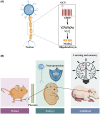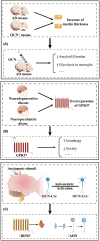Roles of osteocalcin in the central nervous system
- PMID: 39252492
- PMCID: PMC11386255
- DOI: 10.1111/cns.70016
Roles of osteocalcin in the central nervous system
Abstract
Background: Bone-derived protein osteocalcin, which has beneficial effects on brain function, may be a future research direction for neurological disorders. A growing body of evidence suggests a link between osteocalcin and neurological disorders, but the exact relationship is contradictory and unclear.
Scope of review: The aim of this review is to summarize the current research on the interaction between osteocalcin and the central nervous system and to propose some speculative future research directions.
Major conclusions: In the normal central nervous system, osteocalcin is involved in neuronal structure, neuroprotection, and the regulation of cognition and anxiety. Studies on osteocalcin-related abnormalities in the central nervous system are divided into animal model studies and human studies, depending on the subject. In humans, the link between osteocalcin and brain function is inconsistent. These conflicting data may be due to methodological inconsistencies. By reviewing the related literature on osteocalcin, some comorbidities of the bone and nervous system and future research directions related to osteocalcin are proposed.
Keywords: bone–brain crosstalk; central nervous system; comorbidity; osteocalcin.
© 2024 The Author(s). CNS Neuroscience & Therapeutics published by John Wiley & Sons Ltd.
Conflict of interest statement
All authors state that they have no competing interests.
Figures




References
-
- Hauschka PV, Lian JB, Cole DE, Gundberg CM. Osteocalcin and matrix Gla protein: vitamin K‐dependent proteins in bone. Physiol Rev. 1989;69(3):990‐1047. - PubMed
-
- Ivaska KK, Hentunen TA, Vääräniemi J, Ylipahkala H, Pettersson K, Väänänen HK. Release of intact and fragmented osteocalcin molecules from bone matrix during bone resorption in vitro. J Biol Chem. 2004;279(18):18361‐18369. - PubMed
-
- Power MJ, Fottrell PF. Osteocalcin: diagnostic methods and clinical applications. Crit Rev Clin Lab Sci. 1991;28(4):287‐335. - PubMed
Publication types
MeSH terms
Substances
Grants and funding
LinkOut - more resources
Full Text Sources
Research Materials

